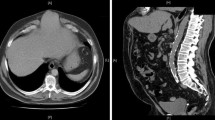Abstract
Background
The main principle of incisional hernia repair with mesh augmentation is a wide overlap of at least 5 cm in all directions. This is complicated when cartilaginous or osseous structures border the fascial defect, most notably at the xiphoid after sternotomy or in large proximal incisional hernias.
Method
We performed an anatomic investigation of this “problematic” area with its different structures and layers that form the retroxiphoidal space.
Results and conclusion
The posterior lamina of the rectus sheath inserts on the posterior side of the xiphoid. This lamina inhibits a sufficient mesh placement. By sharp dissection dorsal the xiphoid process, the posterior lamina of the rectus sheath can be detached. This way the retroxiphoidal space can be opened. Further development of this space can be made by blunt dissection. In some cases, with retroxiphoidal scar formation after sternotomy, a sharp dissection might be necessary. This enables a combined retromuscular-retroxiphoid mesh augmentation repair with a sufficient underlay of at least 5 cm, according to the principles of sublay technique.




Similar content being viewed by others
References
Hoer J, Lawong G, Klinge U, Schumpelick V (2002) Factors Influencing the Development of Incisional Hernia. A Retrospective Study of 2,983 Laparotomy Patients Over a Period of 10 Years. Chirurg 73:474–80
Davidson BR, Bailey JS (1986) Incisional Herniae Following Median Sternotomy Incisions: Their Incidence and Aetiology. Br J Surg 73:995–6
Schumpelick V, Junge K, Rosch R, Klinge U, Stumpf M (2002) Retromuscular Mesh Repair for Ventral Incision Hernia in Germany. Chirurg 73:888–94
Zimmer EA (1939) The sternum and its joints. Archive and atlas of the normal and pathological anatomy in typical x-ray pictures. RÖFO Erg. Bd.58 ed.Leipzig: Thieme
Schumpelick V, Conze J, Klinge U (1996) Preperitoneal Mesh-Plasty in Incisional Hernia Repair. A Comparative Retrospective Study of 272 Operated Incisional Hernias. Chirurg 67:1028–35
Read RC, Yoder G (1989) Recent Trends in the Management of Incisional Herniation. Arch Surg 124:485–8
Cohen MJ, Starling JR (1985) Repair of Subxiphoid Incisional Hernias With Marlex Mesh After Median Sternotomy. Arch Surg 120:1270–1
Cohen MJ, Starling JR (1985) Repair of Subxiphoid Incisional Hernias With Marlex Mesh After Median Sternotomy. Arch Surg 120:1270–1
Merrell RC, Than-Trong T (1985) Osseous and Chondral Fixation of Polypropylene Mesh. Am J Surg 149:816–8
Landau O, Raziel A, Matz A, Kyzer S, Haruzi I (2001) Laparoscopic Repair of Poststernotomy Subxiphoid Epigastric Hernia. Surg Endosc 15:1313–4
Barner HB (1987) A Technical Modification of Median Sternotomy to Eliminate Subxiphoid Incisional Hernias. Arch Surg 122:843
Author information
Authors and Affiliations
Corresponding author
Rights and permissions
About this article
Cite this article
Conze, J., Prescher, A., Kisielinski, K. et al. Technical consideration for subxiphoidal incisional hernia repair. Hernia 9, 84–87 (2005). https://doi.org/10.1007/s10029-004-0239-0
Received:
Accepted:
Published:
Issue Date:
DOI: https://doi.org/10.1007/s10029-004-0239-0




